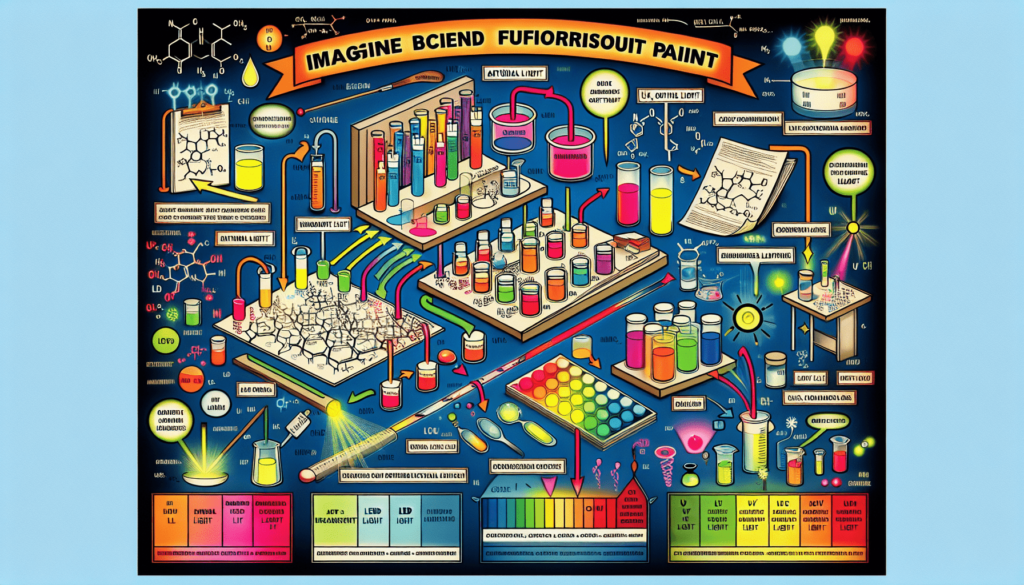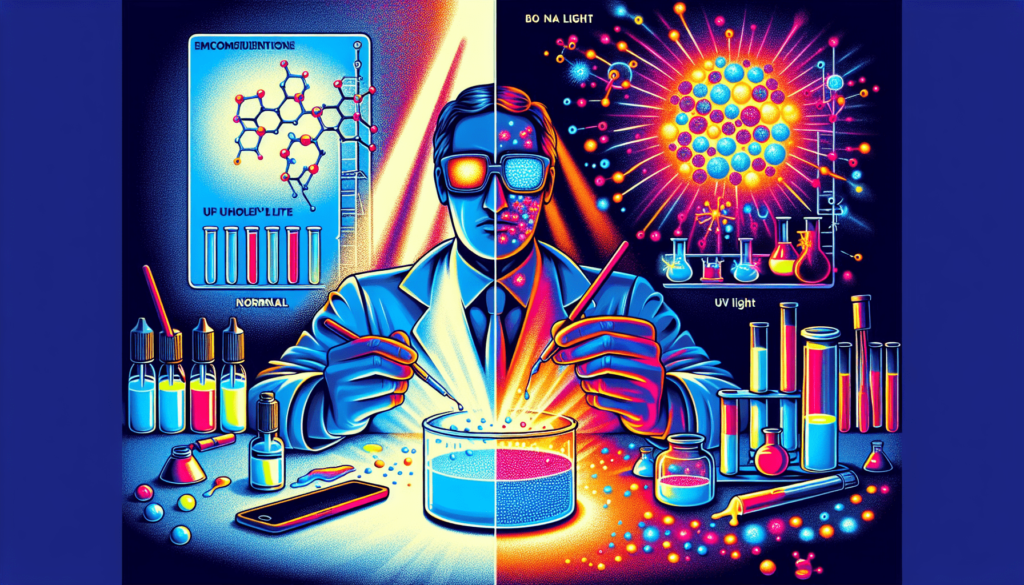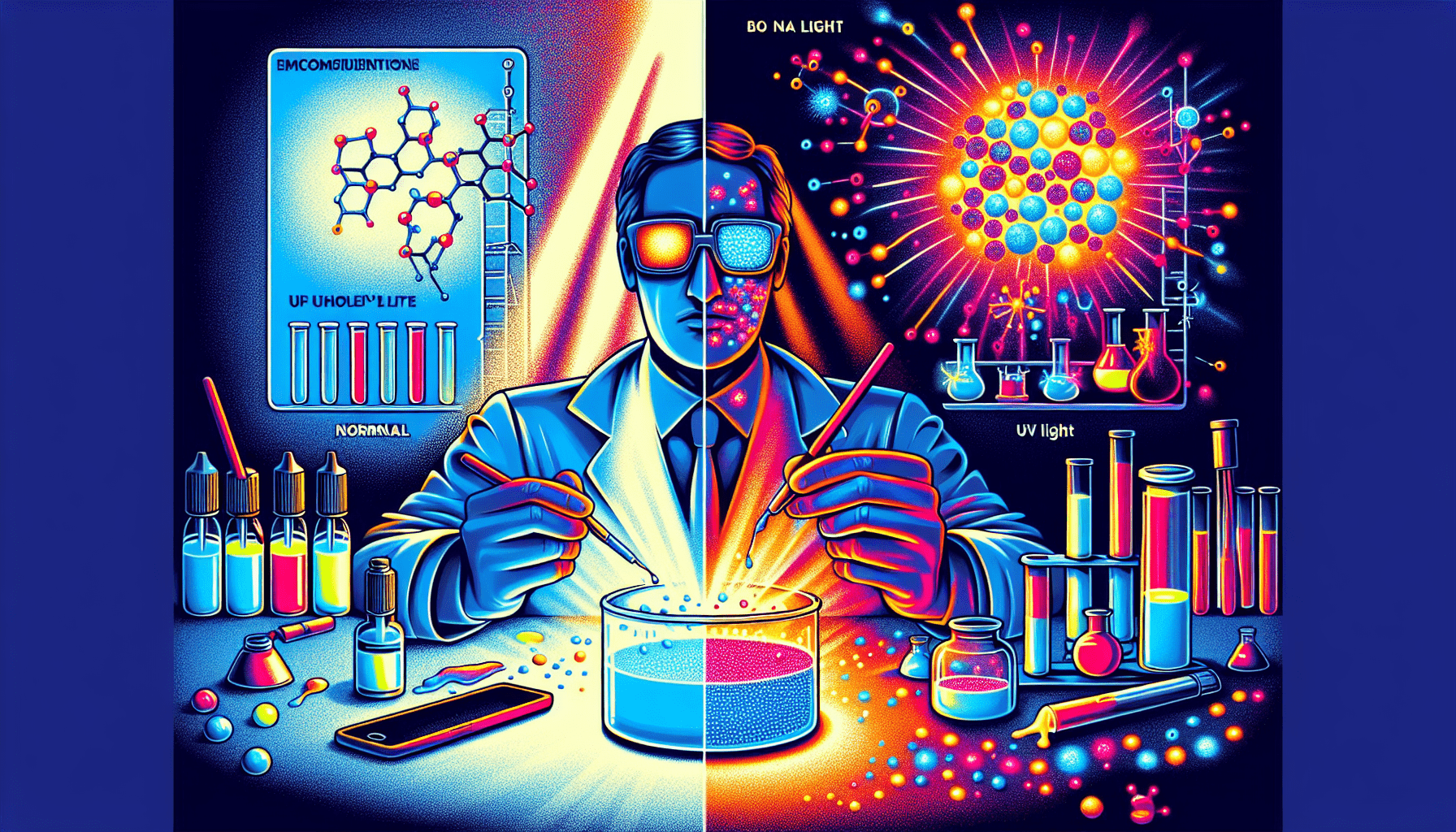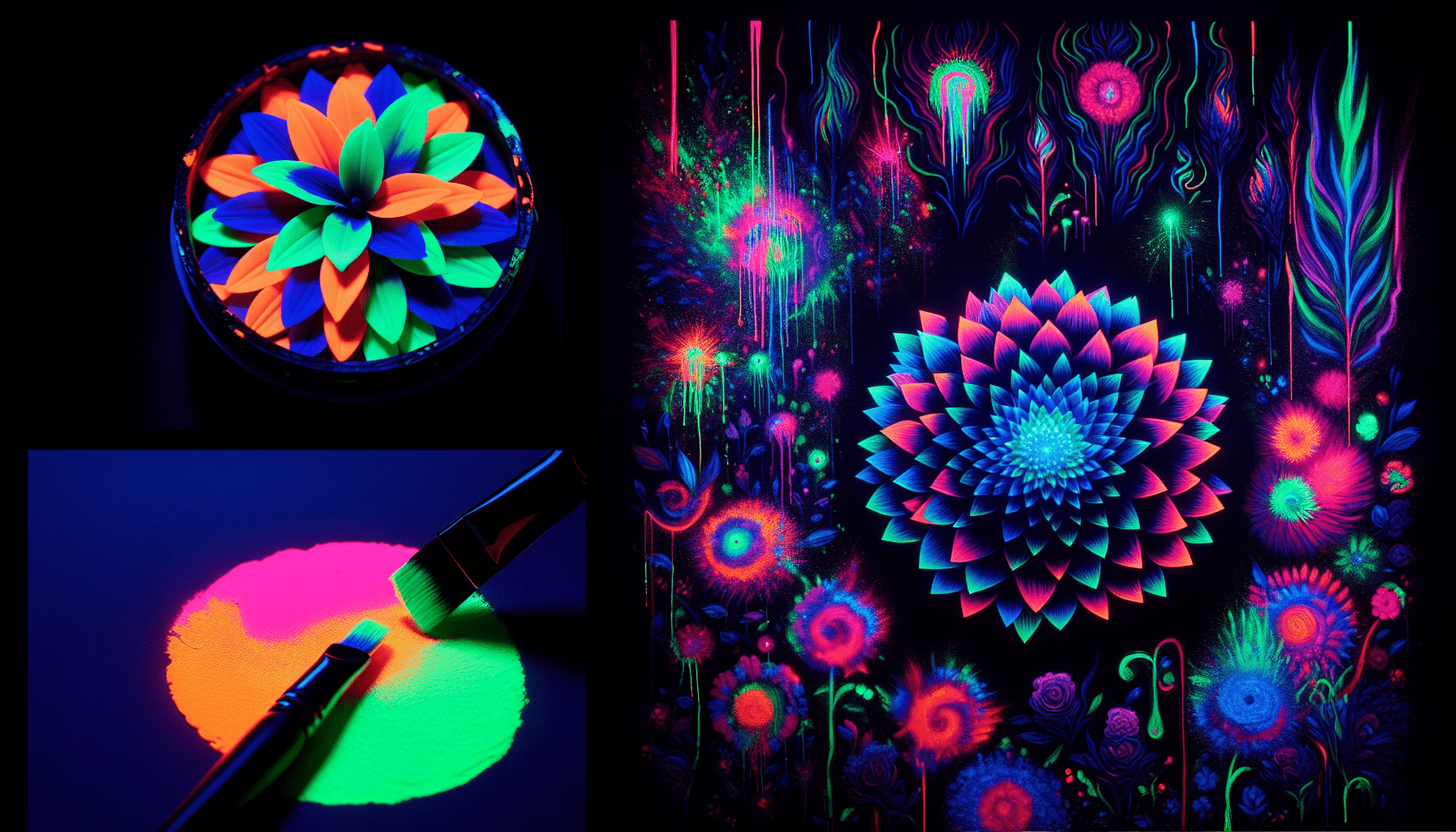Fluorescent paint, a vibrant and eye-catching medium used in various industries, has long been associated with UV light. However, there is a lingering question about whether fluorescent paint actually requires UV light for its illuminating effects. In the quest for a definitive answer, this article aims to shed light on the relationship between fluorescent paint and UV light, exploring the mechanisms behind its fluorescence and examining the implications for artists, designers, and enthusiasts alike. By the end, you will have a comprehensive understanding of the role UV light plays in unleashing the full potential of fluorescent paint and how it can be effectively utilized.

What is fluorescent paint?
Definition
Fluorescent paint is a type of paint that contains fluorescent pigments, which are specially designed to emit light when they are exposed to certain wavelengths of light. This type of paint is characterized by its ability to visibly glow and create highly vibrant and intense colors, making it popular for various applications such as safety and visibility, arts and crafts, and scientific research.
Characteristics
Fluorescent paint has several key characteristics that distinguish it from conventional paints. Firstly, it has a higher concentration of pigments, which are capable of absorbing UV light and converting it into visible light. This results in a brighter and more intense color that can be easily noticed even in low-light conditions. Additionally, fluorescent paint exhibits a unique property called fluorescence, which means it continues to emit light for a short period after the excitation light source is removed. This persistence of fluorescence is another distinctive feature of fluorescent paint.
How does fluorescent paint work?
Principle of fluorescence
The working principle of fluorescent paint lies in the process of fluorescence. When fluorescent pigments in the paint are exposed to UV light, they absorb the high-energy photons and become excited. This excitation causes the electrons in the pigments to move to a higher energy state. However, these excited electrons are unstable and quickly return to their original energy level, releasing the excess energy as visible light.
Excitation and emission
To achieve the desired fluorescence effect, fluorescent paint requires a specific type of light called the excitation light. This light must have a shorter wavelength than the emitted light. When the excitation light interacts with the pigments, it triggers the absorption of energy and subsequent emission of visible light. The emitted light typically has a longer wavelength and a different color than the excitation light.
Types of fluorescent pigments
There are various types of fluorescent pigments used in fluorescent paints, each with its unique characteristics and color properties. Some common types include daylight fluorescent pigments, which emit fluorescent light under natural daylight; daylight-fluorescent pigments, which produce enhanced fluorescence under daylight; and general-type fluorescent pigments, which are suitable for a wide range of applications. The choice of pigment depends on the specific requirements of the application and the desired fluorescent effect.
Properties of UV light
Definition of UV light
UV light, or ultraviolet light, is a type of electromagnetic radiation that has a shorter wavelength and higher energy than visible light. It is generally categorized into three types: UV-A, UV-B, and UV-C. UV-A has the longest wavelength and is closest in range to visible light. UV-B has a shorter wavelength and is responsible for causing sunburn. UV-C has the shortest wavelength and is typically filtered by the Earth’s atmosphere.
Wavelength range
UV light spans a range of wavelengths from 10 nanometers to 400 nanometers. Within this range, different wavelengths of UV light have varying effects on materials and biological organisms. In relation to fluorescent paint, the particular range of UV light that is capable of exciting the fluorescent pigments and causing them to emit visible light falls within the UV-A range, typically between 315 and 400 nanometers.
Effects on fluorescent materials
When exposing fluorescent materials, such as fluorescent paint, to UV light, several effects occur. Firstly, the UV light is absorbed by the pigments, resulting in the excitation of electrons and the subsequent emission of visible light. Secondly, the intensity and duration of the fluorescence depend on the intensity and wavelength of the incident UV light. The absorption and emission properties of fluorescent pigments are optimized for specific UV light wavelengths, ensuring efficient and vibrant fluorescence.
Does fluorescent paint require UV light?
Fluorescent paint vs. phosphorescent paint
It is important to differentiate between fluorescent paint and phosphorescent paint, as they have distinct properties and requirements. Fluorescent paint requires an external light source, such as UV light, to emit visible light and create fluorescence. Once the excitation light is removed, the fluorescence gradually diminishes. On the other hand, phosphorescent paint can glow in the dark without an external light source. It absorbs and stores energy from ambient light or artificial light, and then slowly releases that energy in the form of visible light.
UV light as an excitation source
Fluorescent paint relies on UV light as the primary excitation source to trigger fluorescence. The pigments in the paint are specifically designed to absorb UV light and convert it into visible light. Without UV light, the fluorescent pigments within the paint cannot be excited and will not emit visible light. Consequently, using UV light is essential for achieving the vibrant and glowing effects associated with fluorescent paint.
Visible light excitation
While UV light is the main excitation source for fluorescent paint, it is worth noting that certain fluorescent pigments can also be excited by visible light within specific wavelength ranges. This means that fluorescent paint can exhibit fluorescence under certain types of visible light, although the effect may not be as pronounced as when using UV light. However, UV light remains the most effective and commonly used excitation source for fluorescent paint due to its high energy and ability to produce intense fluorescence.

Advantages of using UV light with fluorescent paint
Enhanced brightness and intensity
The use of UV light as an excitation source for fluorescent paint offers several advantages, one of which is enhanced brightness and intensity. UV light has a shorter wavelength and higher energy than visible light, allowing for more efficient energy transfer to the pigments in the paint. This results in a higher degree of excitation and subsequent emission of visible light, leading to a brighter and more intense fluorescence. The use of UV light ensures that the fluorescent paint stands out and is highly visible even in low-light conditions.
Longer persistence of fluorescence
Another advantage of using UV light with fluorescent paint is the longer persistence of fluorescence. UV light is capable of continuously exciting the pigments within the paint as long as it is present. This extended excitation period translates into a longer duration of fluorescence once the excitation source is removed. This property can be particularly useful in applications where visibility is crucial, such as safety signage or artistic displays. The ability of fluorescent paint to remain visibly fluorescent for an extended period enhances its effectiveness and aesthetic appeal.
Versatility in applications
The use of UV light with fluorescent paint offers versatility in a wide range of applications. The vibrant and intense colors produced by fluorescent paint make it highly sought after in safety and visibility applications. It is commonly used for marking hazards, road signs, and safety equipment to ensure visibility in low-light or dark conditions. In arts and crafts, fluorescent paint adds an element of vibrancy and uniqueness, allowing for the creation of visually striking pieces. Moreover, fluorescent paint is utilized in scientific research to label and track biological samples, facilitating observation and analysis.
Alternatives to UV light for activating fluorescent paint
Black light
One alternative to UV light is the use of black light. Black light emits UVA radiation, which is within the range that can excite fluorescent pigments and cause them to fluoresce. Black lights are widely available and can be used as a substitute for traditional UV light sources. However, it is important to note that black light does not emit as much energy as UV light, so the fluorescence produced by fluorescent paint under black light may be slightly less intense.
Fluorescent lamps
Fluorescent lamps, commonly found in commercial and residential lighting fixtures, can also be utilized to activate fluorescent paint. These lamps emit UV-A rays as well as visible light, providing a dual-purpose solution for illumination and excitation. Similar to black lights, fluorescent lamps may not produce as intense fluorescence as dedicated UV light sources, but they can still achieve satisfactory results in certain applications.
LEDs
LEDs (Light-Emitting Diodes) can be used to activate fluorescent paint as they emit light in specific wavelengths. UV LEDs are available and can serve as a UV light source for fluorescent paint. They offer the advantage of being energy-efficient and compact, making them a viable option for applications where portability and power consumption are important considerations. However, certain LEDs may have a narrower wavelength range compared to traditional UV lights, so careful selection and testing may be required to ensure compatibility with fluorescent paint.
Practical applications of fluorescent paint
Safety and visibility
One of the most significant practical applications of fluorescent paint is in safety and visibility. Whether it’s marking hazardous areas, creating high-visibility signs and labels, or painting safety equipment, fluorescent paint ensures enhanced visibility and attention in various environments. The vibrant and glowing colors produced by fluorescent paint make it an effective tool for improving safety measures and reducing accidents, especially in low-light conditions or areas with limited visibility.
Arts and crafts
Fluorescent paint has gained popularity in the world of arts and crafts due to its unique and captivating properties. Artists and crafters can utilize fluorescent paint to create eye-catching paintings, sculptures, and decorative pieces. The intense colors produced by fluorescent paint add a dynamic element to artworks, giving them a striking and vibrant appearance. From canvas paintings and murals to DIY crafts and wearable art, fluorescent paint adds a touch of uniqueness and luminescence to creative projects.
Scientific research
In scientific research, fluorescent paint plays a crucial role in labeling and tracking various specimens and biological samples. Fluorescently labeled molecules, cells, or tissues can be observed and analyzed under a fluorescence microscope, providing valuable insights into cellular and molecular processes. The use of fluorescent paint in research allows for precise visualization of specific structures or components, aiding in the understanding of complex biological systems and facilitating advancements in various scientific fields.
Precautions when using fluorescent paint
Avoid prolonged exposure
While fluorescent paint is generally safe to use, it is important to avoid prolonged exposure to both the paint and any excitation sources, such as UV light. Prolonged exposure to UV light can be harmful to the eyes and skin, and may increase the risk of developing conditions such as cataracts or skin cancer. It is recommended to use protective measures, such as wearing UV-blocking eyewear and using sunscreen on exposed skin, when working with fluorescent paint and UV light sources.
Proper ventilation
When working with fluorescent paint, it is essential to ensure proper ventilation in the working area. The paint may contain volatile organic compounds (VOCs) that can evaporate and release fumes. These fumes can be harmful when inhaled in large quantities or over extended periods of time. Good ventilation can help minimize the concentration of VOCs in the air and provide a healthier environment for working with fluorescent paint.
Use appropriate protective equipment
When handling fluorescent paint, it is advisable to use appropriate protective equipment to minimize the risk of skin contact and inhalation of fumes. This includes wearing gloves, goggles, and a respiratory mask if necessary, depending on the nature and scale of the project. Protective equipment helps ensure personal safety and prevent any potential adverse effects associated with the use of fluorescent paint.
Conclusion
Importance of UV light for fluorescent paint
UV light plays a crucial role in the functioning of fluorescent paint, serving as the primary excitation source for the pigments within the paint. The absorption of UV light by the pigments triggers fluorescence, resulting in the vibrant and glowing colors associated with fluorescent paint. Without UV light, fluorescent paint cannot exhibit its distinctive characteristics and visual appeal.
Exploration of alternative excitation sources
While UV light is the most commonly used excitation source for fluorescent paint, there are alternative options available. Black lights, fluorescent lamps, and LEDs can also activate fluorescent paint, although the intensity of fluorescence may vary. The choice of excitation source depends on the specific requirements of the application and the desired outcome.
Versatility and popularity of fluorescent paint
Fluorescent paint has gained popularity and widespread use due to its versatility and unique properties. It finds applications in various fields, including safety and visibility, arts and crafts, and scientific research. The enhanced brightness, longer persistence of fluorescence, and vibrant colors produced by fluorescent paint make it a preferred choice for many industries and creative endeavors. By understanding the role of UV light and exploring alternative excitation sources, the full potential of fluorescent paint can be realized in different applications.



